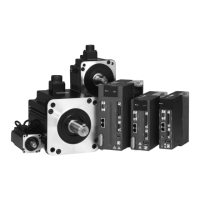Introduction of E-Cam Operation ASDA Series Application Note
2-38 March, 2015
Two examples are presented below to help users create E-Cam curves with Macro 7.
Example 1:
When using Macro 7 to create E-Cam curve and R = 1.1 ~ 5 (when R > 1.0, cutting length is
longer than cutter circumference), adopting rules presented in the diagram (Figure 2.56) can
avoid occurrence of error codes.
Step 1: Figure out the length ratio R first. Make sure the value is within the range of 1.1 ~ 5 or
this flow chart is not applicable.
Step 2: Specify the S level. Then, figure out the proportion of constant speed area and
waiting zone to meet the range condition. Enter all the values to the designated parameters.
Step 3:
1) If not applying speed compensation, the setting is done after calculating value of P5-95
and P5-96.
2) If positive speed compensation is used, which means the slave axis speed is faster
than the master axis, users may consider adjusting the size of the constant speed area
or speed up the slave axis.
Taking adjusting the speed of the slave axis as priority: Select the max. possible
positive speed compensation. Then calculate the variation of the constant speed
area based on this compensation value. A new range of the constant speed area
can thus be acquired.
Taking adjusting the size of the constant speed area as priority: If size of the
constant speed area is the priority, select a new constant speed area to re-define
the range and figure out the required compensation value.
Step 4: After setting the compensation value (Vc) and new range of the constant speed area,
revise the setting of constant speed area.
Step 5: Figure out value of P5-95 and P5-96 and the setting is complete.

